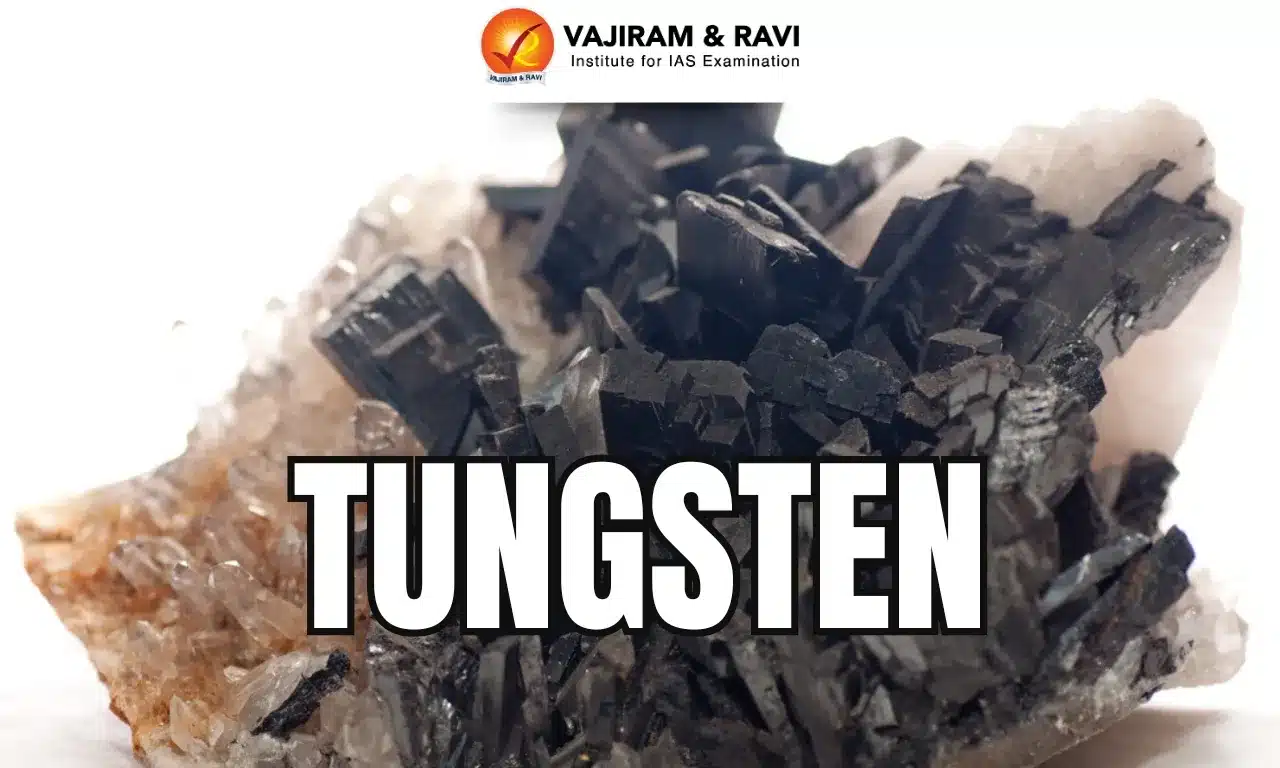Tungsten Latest News
Recently, the Hindustan Zinc Ltd (HZL) has received the licence to explore and mine a tungsten block in Andhra Pradesh.
About Tungsten
- It is a chemical element with the symbol W, and atomic number 74.
- It is a naturally occurring element and classified as a transition metal.
- Major producers: China (major global producer), Vietnam, Russia, and North Korea.
- It has been classified as a Critical Mineral by the Government of India.
Occurrence of Tungsten
- It occurs in rocks and minerals combined with other chemicals, but never as a pure metal.
- It is found in nature in mineral forms like wolframite and scheelite.
Properties of Tungsten
- It has the highest melting point of all metals at 3410 °C.
- It has the lowest vapor pressure of all metals with 4.27 Pa at 3410 °C.
- It has the highest tensile strength of all metals over 1650 °C.
- Tungsten is a solid at room temperature.
- Tungsten alloys tend to be strong and flexible, resist wear, and conduct electricity well.
Uses of Tungsten
- Tungsten is used in products such as x-ray tubes, light bulbs, high-speed tools, and welding electrodes.
- It is also used as a catalyst to speed up chemical reactions.
- Tungsten carbide is immensely hard and is very important to the metal-working, mining and petroleum industries.
- Other tungsten compounds are used in ceramic pigments, as fire retardant coatings for fabrics, and as color-resistant dyes for fabrics.
Source: TH
Last updated on December, 2025
→ Check out the latest UPSC Syllabus 2026 here.
→ Join Vajiram & Ravi’s Interview Guidance Programme for expert help to crack your final UPSC stage.
→ UPSC Mains Result 2025 is now out.
→ UPSC Notification 2026 is scheduled to be released on January 14, 2026.
→ UPSC Calendar 2026 is released on 15th May, 2025.
→ The UPSC Vacancy 2025 were released 1129, out of which 979 were for UPSC CSE and remaining 150 are for UPSC IFoS.
→ UPSC Prelims 2026 will be conducted on 24th May, 2026 & UPSC Mains 2026 will be conducted on 21st August 2026.
→ The UPSC Selection Process is of 3 stages-Prelims, Mains and Interview.
→ UPSC Result 2024 is released with latest UPSC Marksheet 2024. Check Now!
→ UPSC Prelims Result 2025 is out now for the CSE held on 25 May 2025.
→ UPSC Toppers List 2024 is released now. Shakti Dubey is UPSC AIR 1 2024 Topper.
→ UPSC Prelims Question Paper 2025 and Unofficial Prelims Answer Key 2025 are available now.
→ UPSC Mains Question Paper 2025 is out for Essay, GS 1, 2, 3 & GS 4.
→ UPSC Mains Indian Language Question Paper 2025 is now out.
→ UPSC Mains Optional Question Paper 2025 is now out.
→ Also check Best IAS Coaching in Delhi
Tungsten FAQs
Q1. Which mineral is a major source of Tungsten?+
Q2. What is the melting point of Tungsten?+
Tags: prelims pointers Tungsten upsc current affairs upsc prelims current affairs

















